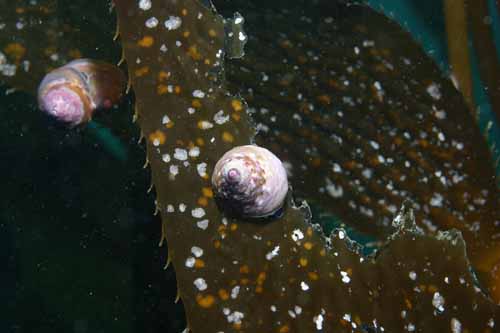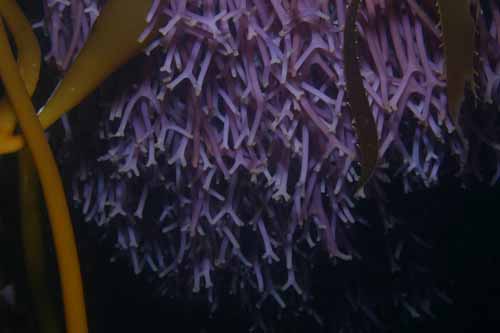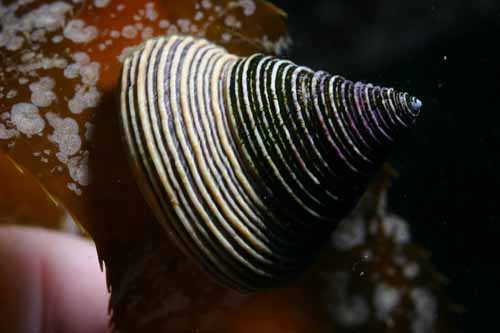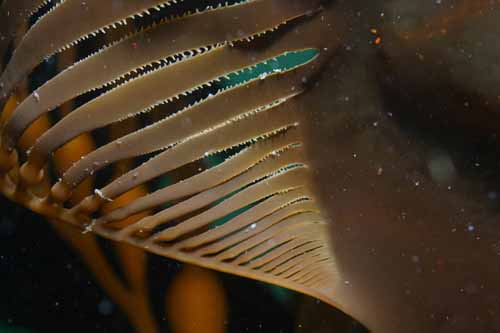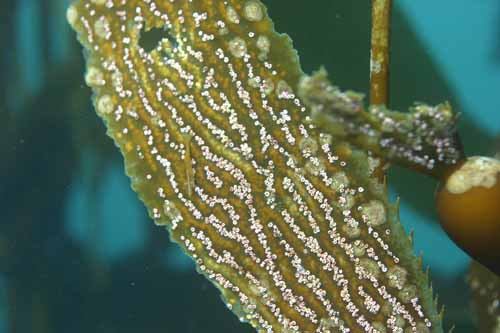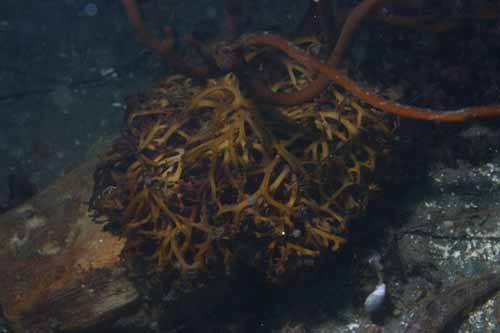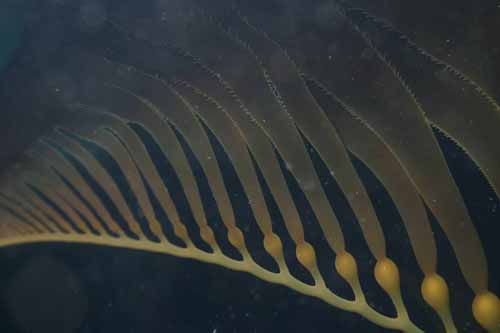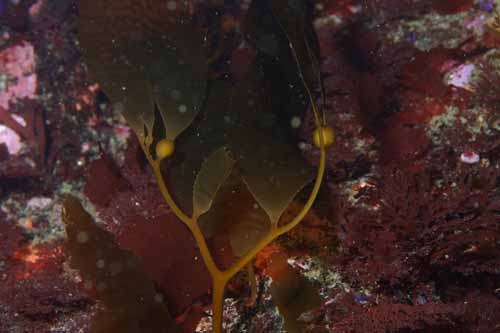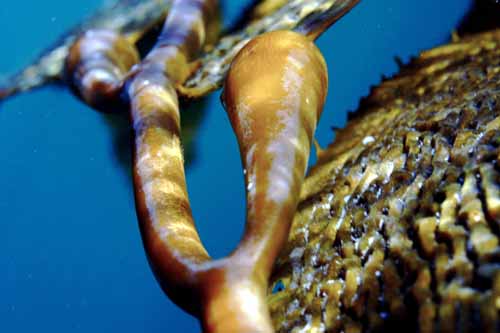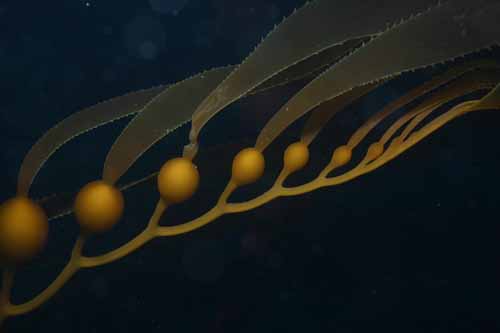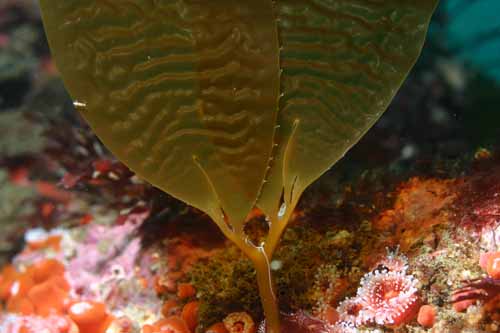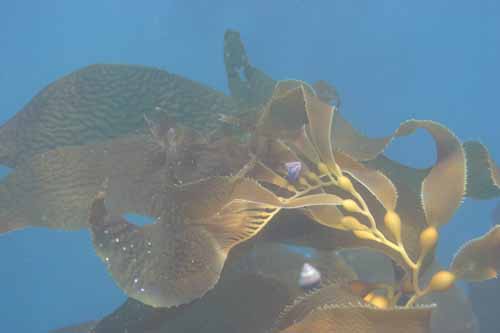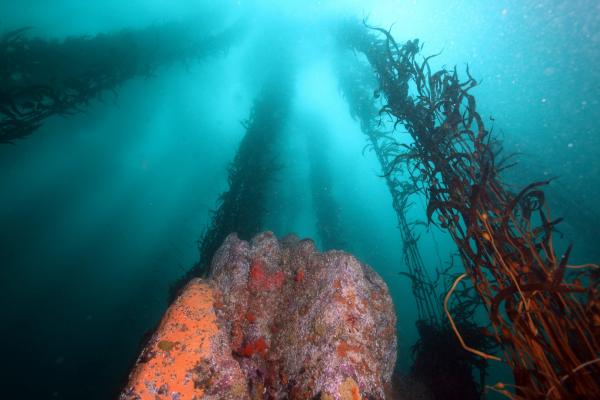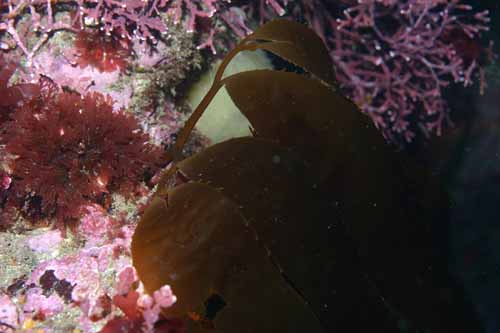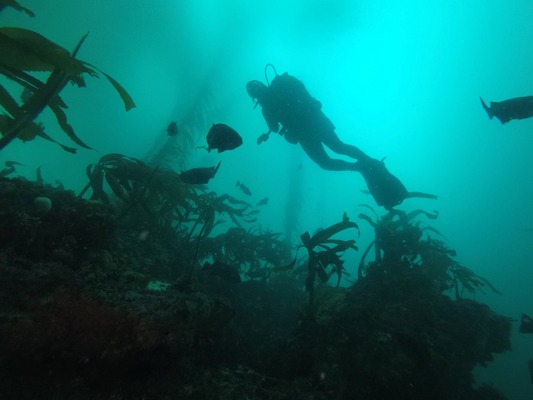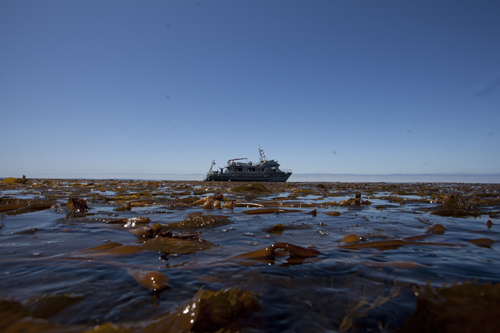
Giant kelp
Macrocystis pyrifera
Overview
Key Features:
Individuals consist of many stipes, each with oval-elongated pneumatocysts and a long, tapered blade.Similar Species:
Bull kelp (Nereocystis luetkeana)Kelp (Macrocystis integrifolia)
Primary Common Name:
Giant kelpGeneral Grouping:
Brown seaweed/algaeGeographic Range:
Southeast Alaska to Baja California, Mexico
Macrocystis pyrifera is found from Southeast Alaska to Baja California, Mexico and also in Peru, Chile, Argentina, Tasmania, and New Zealand.Intertidal Height:
-2 to -2 feet (-0.6006006 to -0.6006006 meters)Notes:
Macrocystis pyrifera can be found in the low intertidal as a recruit, but it does not grow to adulthood in this habitat.Subtidal Depth Range:
Minimum Depth: 3 meters or 10 feetMaximum Depth: 30 meters or 99.9 feet
Notes:
Macrocystis pyrifera can be found in the subtidal.Habitats:
bay (rocky shore), exposed rocky shore, kelp forest, protected rocky shoreNotes:
Macrocystis pyrifera mostly grows attached to rocky substrate at depths between 6-30 meters. These algae grow best in turbulent, nutrient rich waters and need sunlight to survive.Macrocystis pyrifera dampens surge, thereby providing essential shelter for many species of adult fish and serving as a nursery for juveniles as well. Studies have shown that in California up to 100 species of fish are dependent on Macrocystis pyrifera forests. Macrocystis pyrifera also provides habitat for sea otters, Enhydra lutris. The leaflike blades of Macrocystis pyrifera provide a leaflike substratum for countless organisms that then become food for masses of browsers. The white spots commonly found on Macrocystis pyrifera blades are likely newly settled colonies for the encrusting bryozoan, Membranipora membranacea.
The holdfast and haptera of Macrocystis pyrifera provide refuge to a diverse community of small organisms, including mollusks, polychaetes, brittle stars, and crustaceans such as isopods and amphipods.
Abundance:
Relative Abundance:
Macrocystis pyrifera frequently grows in dense kelp forests, on rocky shores, low intertidal and subtidal.Species Description:
General:
Macrocystis pyrifera is a brown algae, and like all plants and seaweeds, brown algae need chlorophyll as well as sunlight for photosynthesis and growth. This incredible kelp may be the fastest growing organism in the world with growth rates reaching a phenomenal 50 cm a day in ideal conditions. Growth is limited by nitrogen and light, therefore ideal conditions would include upwelling, which provides renewed supplies of nutrients, and lots of sunlight. Gas-filled bladders at the base of the leaflike blades support the growing fronds of the anchored Macrocystis pyrifera as they grow towards and spread out along the surface in a dense canopy.Distinctive Features:
Macrocystis pyrifera clings to a rock foundation by means of its holdfast, which sole purpose is to anchor the plant to a rock; it does not provide a proper root system. The holdfast is a coneshaped mass made up of branching extensions called haptera. Numerous stemlike stipes, often 4 or 5 times dichotomously divided near the base, arise from a holdfast and are tough but flexible, allowing the kelp to sway in ocean currents. Along the stipe, blades occur at regular intervals.Size:
Macrocystis pyrifera generally grows to 30 m, but can grow to 53 m in ideal conditions.Natural History:
General:
There are two species of Macrocystis along the Pacific coast of North America and they are differentiated by their holdfast morphology. Macrocystis pyrifera has a large, conical holdfast that is composed of branched haptera; in older plants this holdfast may be one meter tall. In contrast, Macrocystis integrifolia has a flattened, prostrate holdfast with numerous haptera that arise from its margin. Macrocystis integrifolia has the northernmost distribution of the two species, from Alaska to Monterey, California in the low intertidal and subtidal. The main distribution of Macrocystis pyrifera is Monterey, California to Baja California, Mexico, however there are suspected populations further north and in Alaska both species are often considered identical.Macrocystis pyrifera lives, on average, for six to eight years. The structure of the kelp forest is very dynamic and can change rapidly depending on factors such as storms, weather, temperature, and herbivory. This species will often die back to its holdfast each winter, as much as three quarters of an individual can be lost during the winter season. Individuals can also die due to sediment accumulation or herbivory, where creatures burrow too far into the haptera eventually weakening the holdfast. When holfasts are weakened, they are more likely to be torn from the rocky substrate during storms and may in turn entangle themselves in the forest canopy ripping out other individuals in the process.
Predator(s):
A plethora of predators feed on Macrocystis pyrifera, including turban snails, Tegula, red sea urchins, Strongylocentrotus franciscanus, purple sea urchin, Strongylocentrotus purpuratus, northern kelp crab, Pugettia producta, bat stars, Asterina miniata, sand-beach isopods, Tylos punctatus and concave isopods, Pentidotea resecata. Sea urchins normally eat pieces of kelp that fall to the seafloor, however during populations surges they will feed on stipes and holdfasts of Macrocystis pyrifera and can completely destroy a kelp bed. Enhydra lutris help preserve kelp forests by feeding on urchins.An additional way that kelp provides food for communities is through rafts of torn blades and stipes that are blown ashore providing food for the beach community, and rafts that sink providing nourishment in benthic communities. On the beach, nematodes, amphipods, fly larvae, decomposing bacteria and fungi will feast on washed ashore algal mats and reduce the mass to a heap of detritus and dissolved organic matter in a few days. Waves and tides will often return huge amounts of this organic matter to the sea releasing nutrients into the water and providing food for suspension feeding creatures and other animals. Pieces of decomposing kelp can also sink to the depths of the ocean, providing nourishment for deep sea creatures.
Humans also harvest Macrocystis pyrifera, mainly as a source for algin. Algin is an emulsifying and binding agent used in the production of many foods and cosmetics, such as salad dressings, ice cream, toothpaste, and cereals. Macrocystis pyrifera is also utilized to make kelp tablets used as a source of vitamins and minerals. Because Macrocystis pyrifera lacks tannins, it is more palatable than some other species of brown algae.
Prey:
Macrocystis pyrifera nourishes itself through photosynthesis, converting the energy of light to the energy of carbohydrate molecules.Feeding Behavior:
PhotosyntheticNotes:
The blades of Macrocystis pyrifera, especially mature blades that are near the surface, have the highest photosynthetic rates and the holdfasts have none. The stipes attached to the blades contain sieve tubes, which are structures that transport the products of photosynthesis and minerals in a manner analogous to the movements of sap in vascular plants. Through use of the sieve tubes, excess photosynthetic products can move down to the dimly lit basal portions of the alga where these products are needed.Seasonal Behavior
January - December
Reproduction:
Macrocystis pyrifera has specialized blades clustered immediately above the holdfast that produce huge numbers of haploid male and female spores. A single blade can produce up to 500,000 spores an hour. The spores are propelled by two flagella and often settle within a few meters of their release. They have been known to settle in densities up to 200 spores/cm2, and this proximity enhances the chances of eventual fertilization. They can also swim for as long as three days, and thus can colonize several kilometers away from where they are released. These motile spores tend to swim actively towards sources of nutrients needed for growth, such as nitrogen. Pulses of spores seem to be synchronized by environmental factors such as storms. Recruitment can be limited by low light levels, therefore when storms clear out a Macrocystis pyrifera canopy, recruitment can be episodic.References
O'Clair, R.M. 2000. North Pacific Seaweeds. Plant Press, Auke Bay, Alaska. 162 p.
- Langstroth, L. and L. Langstroth. 2000. A Living Bay: The Underwater World of Monterey Bay. University of California Press, Berkeley and Los Angeles, CA. 287 p.
- Mondragon, J. 2003. Seaweeds of the Pacific Coast: common marine algae from Alaska to Baja California. Sea Challengers, Monterey, CA. 97 p.
- Ricketts, E. F., J. Calvin, and J.W. Hedgpeth. 1985. Between Pacific tides. Stanford University Press, Stanford, CA. 652 p.
- Vasquez, J.A. 1993. Effects on the animal community of dislodgment of holdfasts of Macrocystis pyrifera. Pacific Science 47: 180-184.
- WWW
Monterey Bay Aquarium. Online Field Guide, 2008.
http://www.mbayaq.org/efc/living_species/
Accessed [04/27/06]
Accessed 01/30/2009 for Pelagic Cormorant
Accessed 8/19/09 for Bryozoan
Accessed 7/31/09 for Spiny brittle star
Accessed 3/31/09 for Sunflower star
Accessed 8/9/09 for red octopus
Accessed 8/19/09 for Decorator crab
Accessed 7/31/09 for warty sea cucumber
Related Information
Photo Library
Click on an image below to view a larger version in the SIMoN Photo Library. You will also be able to view important information on each photo such as photographer, date, caption and more
